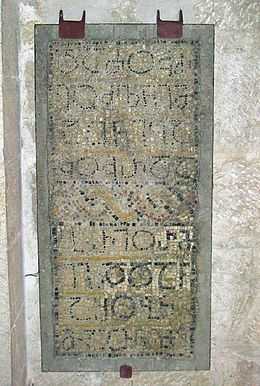Bacurius the Iberian

Bacurius (Georgian: ბაკურ იბერიელი) was a Georgian general of the Byzantine Empire. Bacurius was born into the royal dynasty of the Kingdom of Iberia mentioned by several Greco-Roman authors of the 4th and 5th centuries. It is accepted, but not universally, that all these refer to the same person, an Iberian "king" or "prince", who joined the Roman military ranks. Scholarly opinion is divided whether Bacurius can be identified with one of the kings named Bakur (Georgian: ბაკური), attested in medieval Georgian annals, who might have taken refuge in territories obtained by the Eastern Roman Empire during the Roman–Persian Wars that were fought over the Caucasus.[1]
Ammianus Marcellinus, Tyrannius Rufinus, and Zosimus report that Bacurius was "king of Iberians", but Gelasius of Caesarea does not call him king, but merely scion of the kings of Iberia. Bacurius was a tribunus sagittariorum at the Battle of Adrianople with the Goths in 378 and then served as dux Palaestinae and comes domesticorum until 394, when he became magister militum and commanded a "barbarian" contingent in Emperor Theodosius I’s (r. 379–395) campaign against the Roman usurper Eugenius and met his death, according to Zosimus, at the Battle of the Frigidus. According to Socrates of Constantinople, Bacurius had also fought in Theodosius's earlier campaign against Magnus Maximus.[2][3]
All contemporary sources are unequivocal in praising Bacurius's military skills and courage. Rufinus, whom Bacurius visited several times on the Mount of Olives and served him as a source of Iberia’s conversion to Christianity, describes the general as a pious Christian, while the rhetorician Libanius, with whom Bacurius held correspondence, evidently regards him as a pagan and praises him both as a soldier and a man of culture.[2][4]
References
- ↑ Toumanoff 1969, pp. 31–32.
- ↑ 2.0 2.1 Martindale, Jones & Morris 1971, "Bacurius", p. 144.
- ↑ Burns 1994, p. 106: "Bacurius had been a king of the Iberians in Asia Minor at the time of his entry into the Roman army. He was tribunus sagittariorum at Adrianople in 378 and then dux Palestinae until 394, when he seems to have become magister militum vacans (a special command limited to a specific campaign). As such he probably died at the Frigidus."
- ↑ Hunt 1982, p. 166.
Sources
- Burns, Thomas S. (1994). Barbarians within the Gates of Rome: A Study of Roman Military Policy and the Barbarians, ca. 375–425 A.D. Bloomington, Indiana: Indiana University Press. ISBN 0-253-31288-4.
- Hunt, E. D. (1982). Holy Land Pilgrimage in the Later Roman Empire AD 312-460. Oxford, United Kingdom: Clarendon Press. ISBN 0-19-826438-0.
- Martindale, John Robert; Jones, Arnold Hugh Martin; Morris, J., eds. (1971). The Prosopography of the Later Roman Empire. I: A.D. 260–395. Cambridge, United Kingdom: Cambridge University Press. ISBN 0-521-07233-6.
- Toumanoff, Cyril (1969). "Chronology of the Early Kings of Iberia". Traditio 25: 1–33.